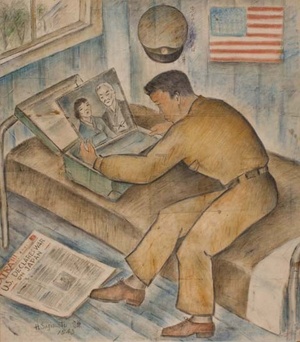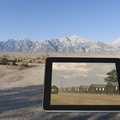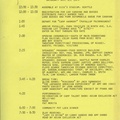Read Chapter 3 (5) >>
Fresh air, a taste of freedom
Yoshiko's father and mother received special permission from the relocation bureau to visit her father's mother and sister in Heart Mountain. Living like a caged bird unconsciously builds up a kind of sediment in the body and mind. Yoshiko was surprised by the state of the two when they returned.
Seeing his mother and sister for the first time since the war began restored my father's energy immeasurably. But what restored their energy even more was the trip itself, which allowed my father and mother to live freely, even if only for a short time, outside the barbed wire fences. When my father and mother returned, they were completely different. My mother looked beautiful and cheerful, and they both seemed refreshed and young again. 1
Volunteer from behind a barbed wire fence — Winter
A message came from Washington saying that the Army had decided to recruit Nisei volunteers. They were going to create a special combat unit made up of Japanese-Americans only. This was good news for the Nisei who had been waiting for this opportunity for a long time .
This is an entry in Kleinkopf's diary, dated January 10th.
In November 1942, a small group of JACL members met in Salt Lake City to discuss the possibility of opening the door to Nisei and proposing a special combat unit made up of Japanese Americans to demonstrate loyalty to the United States and to address prejudice against Japanese Americans.
The government accepted this proposal, and Lieutenant Arnold of the Army came to Minidoka immediately to explain the new policy and begin accepting volunteers. The speech at the first briefing, held on Sunday, February 7th, was reproduced in both English and Japanese in the Minidoka Irrigator dated the following day, February 8th. The same paper also carried a letter from President Roosevelt to Secretary of War Stimson.
The Department of the Army's proposal to organize a fighting force of loyal Japanese American citizens is hereby approved nationwide ....
The following letter was written by high school student Ben when his teacher, Wills, asked if there were any graduates from Garfield High who had applied. It gives us a glimpse into Issei's feelings through Ben's eyes.
April 11, 1943
Dear Dr Wills,
I don't know the names of all the Garfield graduates who applied, but I'll write down the ones I can remember now. First of all, of course, there was Kay and Eddie Sato, Jun Hayakawa, Sadao Baba, Harry and Bill Yanagimachi, Frank Hatanaka...
Some of the names of those already in the military: Sergeant Iwao Kawakami is at a base somewhere in Alaska, and Private Jack Hamada is at Fort Warren, Wyoming. I think Sergeant Paul Sakai is also a Garfield graduate, as his brother Sam attended the school. Is Robert Kirk's name on the teacher's list? He was stationed in the Philippines when the war started, but I don't know where he is now or what has become of him since. Henry Streno also joined the military, and I heard a few months ago that he is training at a flight school.
… I'll give you some reasons why I won't volunteer. First, please understand that I still have some grudge against the government. But that's not the only reason I won't volunteer. I don't believe the government is in a position to ask those who were forcibly interned to volunteer. Either way, I feel like I'll be drafted sooner or later. Americans can't avoid the draft. If I were to join the military, I'd go for the Army. But I hope that all fields are open to those who want to join other military forces. I think it would be fine if they were to recruit volunteers from people who have left the camps and are living freely. If they were to recruit people who have left the camps and are living freely for about six months to a year...
Many Issei are angry at the American government. They throw their children, who have citizenship, into the cage and hurt them, and then they ask them to volunteer, and then they might even be drafted. Some Issei volunteered during World War I. They were promised citizenship to this country because of their service. They were promised better treatment than before. These older Issei ask, what about us now? Did we get American citizenship? Are we being treated better than before? What happened to our jobs? Our children are being trampled on like dogs, even though they are American. By Americans. The government made a lot of promises during the last war. They are making a lot of promises again during this war. They say the promises this time are only as good as the promises they made before.
Dr. Wills, do you know why so many Issei are so harsh on the American government?
But that's not all. When we arrived at our new home, it was still under construction. Many families had to share rooms with complete strangers. Some were put in recreational barracks with strangers. It was hot, the wind was always blowing, and the rooms were covered in dust and mist. It was impossible to get the dust out of the rooms. I remember my mother wiping them down six or seven times a day. There was no hot water, and the water was chlorinated, with a disgusting smell and taste. The toilets were in the open. The men's toilets had no partitions (they still don't have any). When the temperature dropped below zero (-18 degrees Celsius), it was difficult to go to the toilet. There was also a shortage of coal for heat. When it rained, the dust subsided, but the roads were muddy and we had to wear boots. In short, the inmates are forced to live unnecessary and uncomfortable lives, to the point where no one can blame them for becoming bitter.
… I am currently taking classes to become an auto mechanic. …As soon as Kay Sato is drafted, I plan to go to an auto repair shop as an auto mechanic's assistant to gain more knowledge in this field. I feel that I can contribute more to the military after studying to become an auto mechanic. Also, I am against a combat unit made up entirely of Japanese-Americans. If I wait a little longer, I think I will have another chance to volunteer. …
I had no intention of writing a book, but it turned out to be long. Please forgive my long-winded ramblings.
Forever Ben 4
Loyalty Registration — Early Spring

The government felt the need to distinguish between those who pledged loyalty to the United States and those who did not, in order to prevent another riot in the camps. They also began to think that it would be appropriate to release those who pledged loyalty from the camps as soon as possible and allow them to return to normal life. The Army also needed to distinguish between loyalists and non-loyalists when recruiting volunteers, so this time the government created a questionnaire that could be used together with the Army and distributed it to all detainees over the age of 17.
The purpose of the questionnaire was "to determine who should be allowed to emigrate to inland areas; to improve public opinion by giving Nisei males an opportunity to demonstrate their American spirit through military service; and to isolate those who were perceived as disloyal to the U.S. government." The last two questions on the questionnaire caused controversy: "Question 27 asked whether Nisei would be willing to enlist in the U.S. military; and Question 28 asked whether they would swear allegiance to the United States and 'abandon' their loyalty to the Emperor of Japan." 5
These two questions would divide not only families but the entire community. In the next issue, we will take a closer look at the fate of those who answered yes, those who answered no, and those who answered with conditions, as well as the story of the Issei who worked hard to establish a Japanese language library at the Topaz internment camp.
Notes:
1. See above, "People Driven to the Wilderness: Records of a Japanese-American Family During Wartime."
2. Kleinkopf, Arthur. Relocation Center Diary 1942-1946 , Hagerman: Minidoka Internment National Monument, 2003.
3. See above, "Japanese American Ethnicity: Changes through Internment and the Reparations Movement"
4. Letter dated April 11, 1943. Elizabeth Bayley Willis Papers. Acc. No. 2583-6, Box 1. University of Washington Libraries Special Collection.
5. http://nikkeijin.densho.org/reference_ch3_04_loyalty_registration.html
*Reprinted from the 135th issue (October 2013) of the quarterly magazine "Children and Books" published by the Children's Library Association.
© 2013 Yuri Brockett






